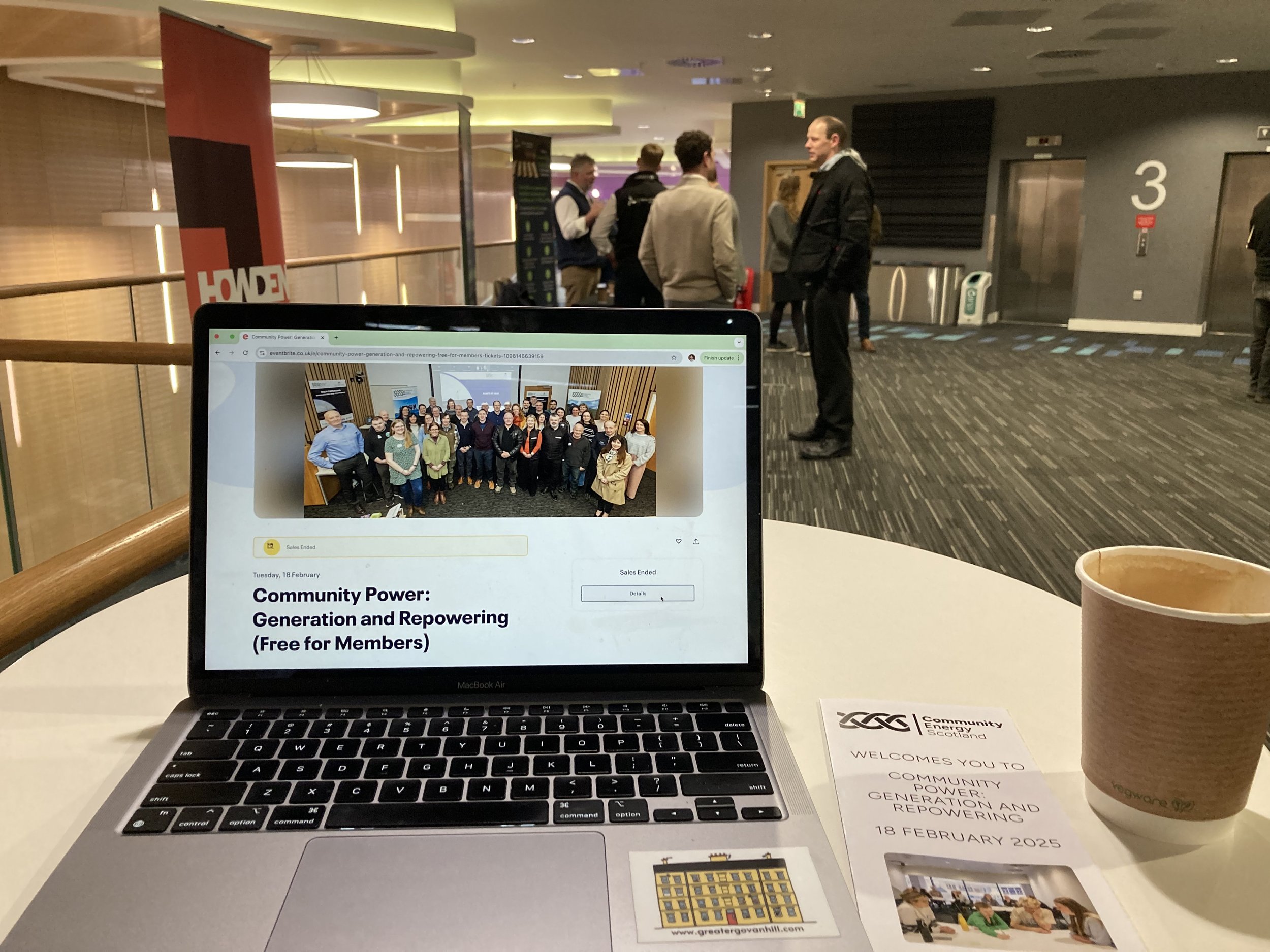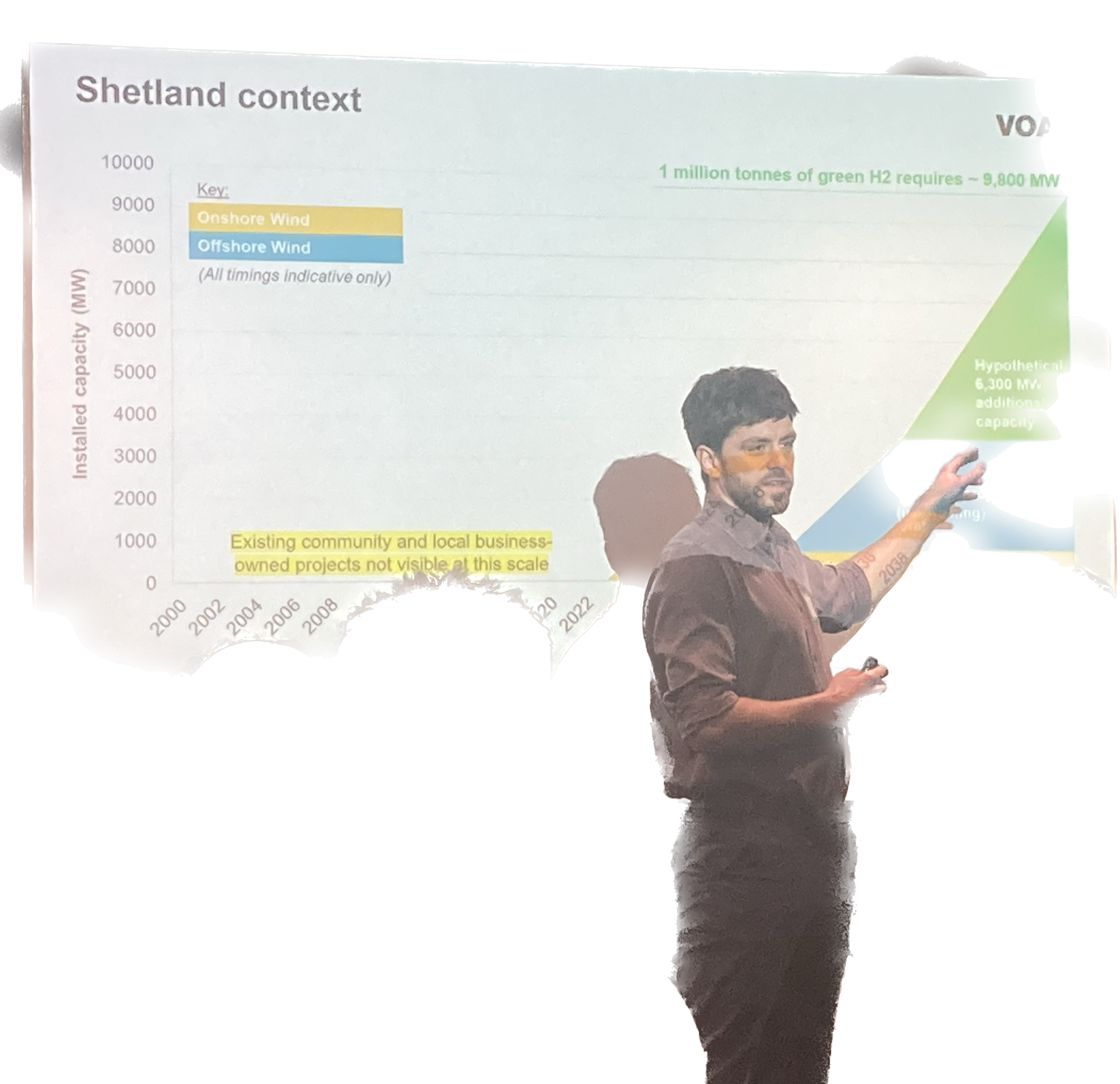Repowering: Communities at the heart of Scotland's renewable future
Clean energy projects face both significant hurdles and critical opportunities as the nation scrambles to meet the new clean energy by 2030 target. With Govanhill announced as Glasgow’s first Net Zero Neighbourhood, we attended Community Energy Scotland’s Community Power event this week to find out more about the potential for Govanhill to lead in the green transition at home.
Attendees at the Community Power Event by hosted by Community Energy Scotland, courtesy of CES.
By Devon McCole | Photos by Devon McCole and Community Energy Scotland
Trying to keep up with the constantly evolving government policies aimed at mitigating climate change can feel like navigating a maze. It’s sometimes confusing, overwhelming, and at times disheartening.
With shifting Net Zero targets and serious questions around where we are at in terms of meeting these goals, the pressure is certainly on. We often hear the window for meaningful change is closing, leaving us with one lingering question: do we, as individuals or communities, have the power to make a difference? How can we shape the future of our shared environment?
Read more: Annie’s Loo—Power and the toilet which changed tenement living
These are questions that come naturally, but often they’re met with answers that underscore the lack of access communities often have, particularly when it comes to resources like funding and their capacity to make meaningful changes.
However, there is a growing incentive for communities to not only participate in but lead the green transition. The idea is simple and exciting: giving communities more ownership over their futures, rather than leaving private offshore companies to call the shots, that are driven by wealth and other influences, often disconnected from the local people they supply with energy.
At the Community Power event hosted by Community Energy Scotland, leading voices from government and grassroots energy groups came together to tackle these very questions and discuss how community-led renewable energy could be the key to shaping a fairer, more sustainable future.
The event was held at Strathclyde University, which was fitting, as Michael Shanks MP for Rutherglen, and Parliamentary Under-Secretary of State Energy, said: “At Stratchclyde University 130 years ago, the first wind turbine was created with the intention of powering streetlights. This city and this university has been at the heart of the renewable energy transition for years.”
With the new clean power by 2030 target looming, they explored both the challenges and opportunities of repowering (refurbishing) Scotland’s energy infrastructure; focusing on funding, policy, and the essential role local ownership plays in not only meeting that target but setting a precedent for future generations to take the lead.
Attendees making their way in to the event.
Michael Shanks added: “This is the first time energy has been at the heart of a government's manifesto. At the heart of that was a commitment to community energy. We established two-institutions: Public Wealth Sector to boost investment and GB Energy, the first publicly owned British energy company. This government is clear that ownership matters.”
Amanda Grimm, Policy Manager at Community Energy Scotland, followed Shanks’ speech, saying “Increased Multi-year funding would give communities the time and resources they need to forge ahead. Community Energy Scotland are calling on the government to give community groups priorities for grid connections – we believe there is a public interest case for due discrimination in favour of community-owned energy.”
A further point was made, that exploring alternative models of funding and support that go beyond government loans, like community bonds, crowdfunded energy projects, or partnerships with socially responsible investors, are more flexible and resilient funding avenues which could empower local groups to forge ahead with often complex but necessary clean energy projects.
After some keynote speeches, other speakers in attendance then shared some examples of innovative new energy projects across Scotland to provide more insight. And, with Govanhill piloting as Glasgow’s first Net Zero Neighbourhood, the event shone a light on some of the ideas and motivations that drive the ambitious plans in Govanhill.
Read more: Govanhill selected as Glasgow’s first Net Zero Neighbourhood
One particular story of interest was Radio City Association’s (RCA), given, as their speaker Scott Wilson said, they lack an engineering background but became interested in a local wind turbine development.
Operating out of a deprived area in Ayrshire, before the ‘80s the booming industry in their area was steel works. Like many communities that relied upon industry, after Margaret Thatcher shut it down there and provided people with little alternatives, the area became increasingly deprived of jobs, funds and resources.
Challenged with balancing tackling poverty and isolation with implementing a just transition towards green energy, RCA started small scale, like by providing free, or cheap clean transport such as bikes/e-bikes for people commuting to work. Their focus has been on creating tangible benefits for residents, not just big ideas people can’t relate to.
Read more: Plant Grow Share Don’t let it go to waste
But RCA wanted to do more, they wanted to bring new industry into the area and return 100 percent of the profits to a community in much need of investment, Scott Wilson of RCA echoed the words of the minister Shanks, who said that morning “ownership matters,” adding “it’s true and it’s why we decided to build our own wind turbine development.”
It’s about having a more circular economy, one that gives back to communities as much as it takes from them. It’s not just about going green, it’s about democratising energy and fostering resilience in communities by giving them a seat at the table.
The major challenge for them, however, has been understanding what’s going on; they have no technical background in energy or that kind of infrastructure building. As amateurs, that lack of appropriate skills, or even understanding of the sector needed to carry out their ambitions, presented huge hurdles: “We probably needed more guidance than other groups present today as energy isn’t our sole focus; community empowerment, creating opportunities and generating wealth for our community are where our interests lie. But we could not ignore the potential of community ownership, especially over locally produced energy, as a way of bringing in jobs and funds for reinvestment into our community. It’s the way the wind is blowing.”
Govanhill isn’t known for its wind – a wind turbine would no doubt be a bit invasive and look very out of place amidst the sea of tenements – but there are other clean energy options that were discussed at Tuesday’s event that would suit Govanhill residents better, and which they could have a stake in, like district heating.
District heating is a system where heat is generated in a centralised location and distributed to nearby buildings through a network of pipes. District heating can make use of waste heat that would otherwise be lost, reducing emissions and energy costs by tapping into renewable energy sources or waste heat from local industries.
A community-owned district heating project would allow profits generated from the sale of heat to stay within the local area, reinvested into the community rather than being extracted by external corporations. It could be a win-win instead of a win-lose scenario.
Govanhill has some real potential for implementing district heating. A district heating network has the potential for reducing emissions and using waste heat, which aligns perfectly with the community’s transition toward becoming the first Net Zero Neighborhood in Glasgow. That on top of the area's high population density and existing infrastructure of tenements and other flatted housing also make it an ideal candidate for a district heating network.
Read more: How can tenement flat owners take on retrofitting their homes?
By tapping into renewable energy sources or waste heat from local industries, Govanhill could significantly reduce carbon emissions while providing sustainable heating for its residents, and in doing so reduce the financial burden on individuals. This would not only help tackle fuel poverty but also contribute to Glasgow’s broader climate goals.
But, more often than not, the duration of a project relies on the funding available. Many in the room, although charged with ambition and ideas for a better future, had some questions and concerns surrounding the extended 2030 deadline for clean energy. Ambitious projects and infrastructure refurbs can take years and cost millions of pounds. Considering long underfunded communities are expected to be given the reigns, challenges surrounding their ability to organise themselves and their capacity to actually deliver, also arise.
One thing was clear as the day came to a close: it’s essential that communities are sufficiently supported by the government and cross-sector partnerships to sustain their goals. It’s exciting that the current government has made available funds for communities to take charge and are talking of the change that is possible, what could be done and what should be done better, but huge strides are needed in the next five years to meet our new target in time.
Tom Wills delivering a presentation on the Garth Windfarm project in Shetland.
As Tom Wills, who spoke about the controversy surrounding the Garth Windfarm project in Shetland, said: “We thought folk would be against any wind farms in the area, but a large majority supported ‘works of the devil’ if reasonable amounts of benefits stayed within the Bressay community.”
Proving that, with great change comes disruption. It is bound to happen, but if it can be justified, if people can have their say, take the lead even, and relate to the goals or see the broader benefits for them, there’s no telling what can be achieved in that time.
I’ll leave you with the words of Dr Alastair Allan MSP, and acting Minister for Climate Action at Holyrood, who said “Repowering offers us the chance to think differently about our Energy use, and more broadly how we think about community, infrastructure and ownership. I recognise that both community and commercially owned energy projects will face challenges in the energy transition but there will be opportunities and support available, and the lessons learned from those projects will inform the transition.”
It’s time to move fast to rebuild and reimagine our energy infrastructure, but this time with communities at the heart of decision making.


